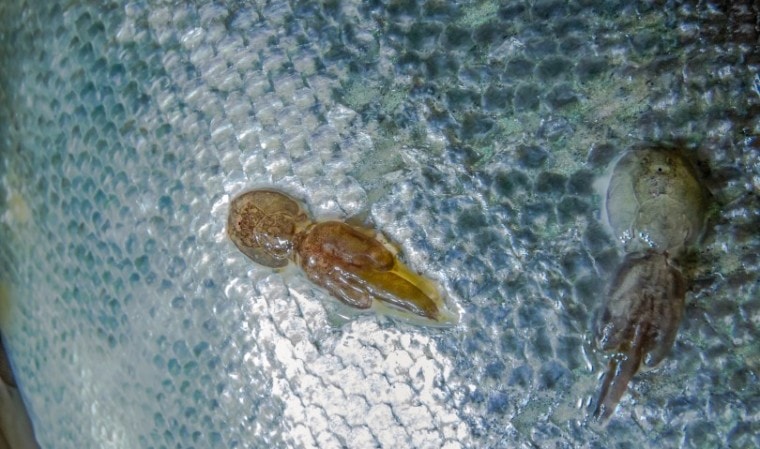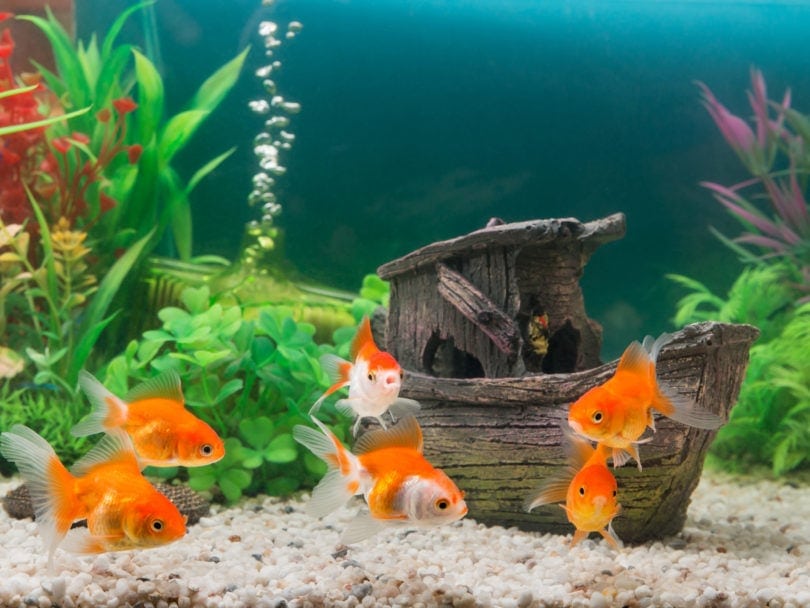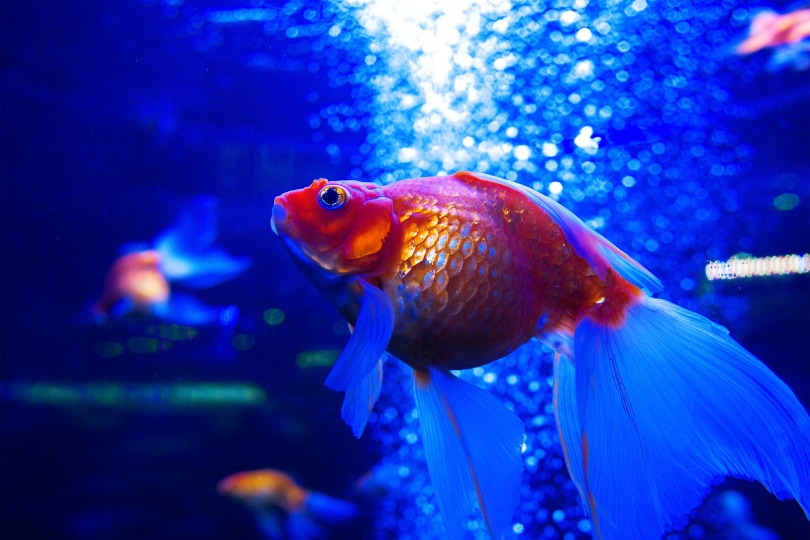
Keeping goldfish isn’t always the most glamorous job. For one thing, you have to properly manage the tank. Few things will make you feel less glamorous than being covered in dirty water while your goldfish beg for food! However, what’s worse is dealing with parasites on your goldfish for the first time. These creepy crawlies can be unsettling for you but uncomfortable and even deadly for your goldfish. Keep reading for more information on goldfish lice and anchor worms.
What Are Goldfish Lice?
Goldfish lice are crustaceans known as copepods, and they go by the scientific name of Argulus trilineatus. They measure approximately 3–4 mm when fully grown and are translucent, which can make them difficult to spot within your tank or on your fish. Males tend to be slightly smaller than females.
Fish lice use a needle-like mouthpart to suck blood from fish, much like a mosquito. If you can get a close look at fish lice, they are usually round and almost alien in appearance. These parasites are highly contagious and can rapidly spread throughout an entire tank if they are not caught and treated early enough.

What Are Anchor Worms?
Like fish lice, anchor worms are copepod crustaceans. They go by the scientific name of Lernaea cyprinacea and are easier to spot than fish lice. Anchor worms attach to a fish via their mouthparts while their bodies jut out from the body of the fish. Anchor worms are ribbon-like and pretty recognizable as parasites when you spot them.
Anchor worms are highly contagious and will quickly infest your whole tank. They can create lesions on your goldfish’s skin, leading to scale loss. They are frequently spotted in and around the gills and gill covers. Sometimes, they aren’t particularly noticeable until you see them moving as your fish’s gills open and close with respiration.
If your fish isn't behaving or looking as it normally does and you suspect it may be sick, ensure you provide the right treatment, by checking out the best-selling and comprehensive book The Truth About Goldfish on Amazon today. It has entire chapters dedicated to in-depth diagnoses, treatment options, a treatment index, and a list of everything in our fishkeeping medicine cabinet, natural and commercial (and more!).

What Are the Signs of Fish Lice and Anchor Worms?
Fish lice are visible on goldfish, though they can be difficult to see. They usually show up as small, greenish dots or flecks across the body of your goldfish. Anchor worms appear as small, white, ribbon-like worms that hang out from the body of the fish, usually sticking out from between scales.
Goldfish with fish lice or anchor worms will often exhibit flashing, which is a behavior that involves rapidly darting around the tank and attempting to rub up against items within the tank. Flashing indicates itching or discomfort and is usually done in an attempt to eliminate this sensation. Other signs may include fin clamping, rapid breathing, pale coloration of the gills, lethargy, and inappetence.
How Can I Treat Goldfish Lice and Anchor Worm?
If left untreated, fish lice and anchor worms can lead to severe anemia, secondary infections, and death. Both of these parasites will reproduce and spread within your tank until they are treated. The most effective treatment for fish lice is medications with cyromazine as the active ingredient. Cyromazine is an antiparasitic that works by limiting the parasite’s ability to produce and maintain its exoskeleton. Without an exoskeleton, these creatures will die. While cyromazine is a highly effective treatment for fish lice and anchor worms, it is unlikely to kill all the parasites within a few days due to its mechanism of action.
If you’ve treated your fish with cyromazine and are still seeing indications of an active infestation, you may need to continue or repeat the treatment. Make sure to carefully follow the instructions on the product you are using, though. Since this is an antiparasitic medication, an overdose can kill your goldfish and anything else in the tank with it.
- You May Also Like: 20 Goldfish Diseases
How Can I Prevent Goldfish Lice and Anchor Worms?
Due to the contagious nature of both these pests, the best treatment is prevention. Both parasites can weasel their way into your tank via new fish or plants, or via infested water, like if you were to introduce a fish from the local pet store directly into your tank. The best prevention for parasites like these is to initiate a quarantine protocol for new fish and plants before you introduce them to your tank. Plants can be quarantined or given a bleach or hydrogen peroxide dip, but new fish and other animals should be quarantined in a separate tank for 2 weeks at a minimum. Ideally, a fish’s quarantine should last from 4 to 8 weeks to ensure that you’ve had ample time to monitor for signs of parasites and other illnesses.
Maintaining good water quality can help prevent and treat fish lice and anchor worms. Routine water changes can help remove eggs and free-swimming parasites in the water column. This can be especially important if you are treating a pond or a tank that you intend to allow to overwinter in cold temperatures. At the end of the season, it’s a good idea to thoroughly clean the pond or tank to avoid having a full-blown infestation on your hands once the warm temperatures roll back around.
Final Thoughts
Fish lice and anchor worms are creepy and unsettling creatures to spot in your tank, but they can be treated. Your best chance of keeping your tank safe and protecting your fish is to prevent these parasites in the first place. However, sometimes this isn’t possible, in which case, early identification and treatment give your fish the best shot at survival with few complications. It’s good practice to visually inspect your fish at least a couple of times per week to ensure that you don’t see any evidence of parasites on the skin, scales, gills, or fins. Catching parasites early will make treating them so much easier!
- Related read: How to Get Rid of Camallanus Worms in Fish
Featured Image Credit : NatureDiver, Shutterstock








